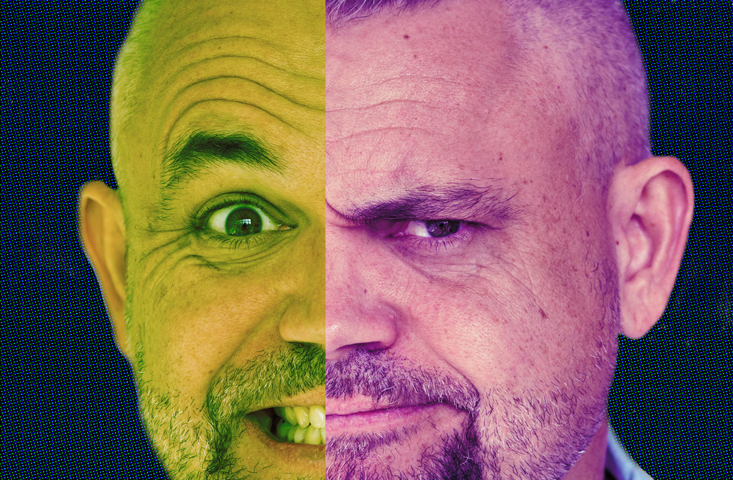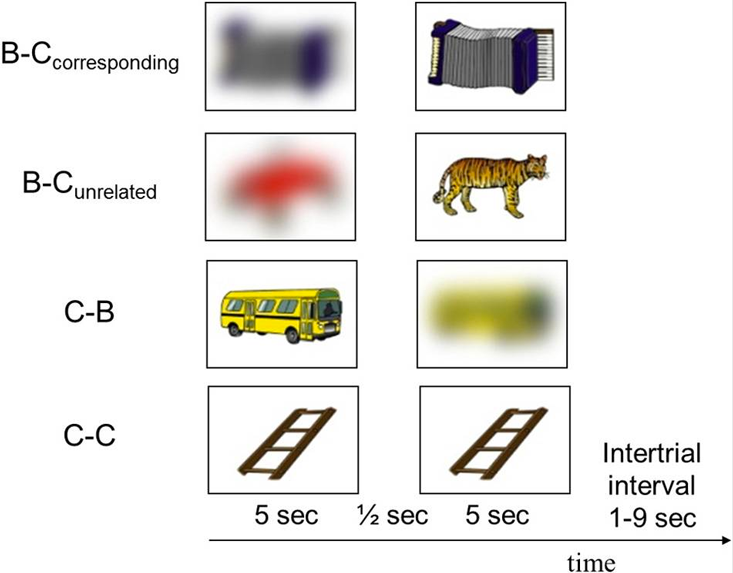How can curiosity be both pleasant and painful?

The funny story associated with Darwin briefly describes the power of curiosity of creative people. When Darwin arrived in Cambridge in 1828, he became an ardent collector of beetles. One day, tearing off the bark from a dead tree, he saw two ground beetles and grabbed one in each hand. At that moment, he suddenly saw a rare ground beetle, known as a big crusader . He did not want to lose a single bug, so he put one of those that he held in his mouth to free his hand for the third. This story did not end very well - Darwin's mouth beetle picked out an irritating chemical substance, and he had to spit it out, as a result of which he lost all three beetles found. But apart from disappointment, this story demonstrates the irresistible attraction of curiosity. But curiosity can be alarming and unpleasant. Are there both of these feelings in the brain at the same time?
Since the early 1990s, neuroscientists have acquired a new powerful tool in their arsenal that allows them to literally capture curiosity in the process. Functional magnetic resonance imaging, fMRI - a procedure that allows researchers to study which region of the brain is activated during a particular mental process. This technology is based on the fact that when a certain area of the brain is used extensively, the energy required for nervous activity causes blood to flow to that area. Therefore, the working brain can be marked in detail by photographing changes in blood flow, using technology based on the fact that in oxygenated blood the magnetic properties are different from blood in which there is little oxygen — this difference can be seen in the images (blood-oxygen-level- dependent, BOLD). In combination with the additional cognitive research, fMRI generates a new dimension of curiosity research. Several experiments in neuroscience have become particularly innovative and influential in developing our understanding of the neurophysiological basis of curiosity.

In a fruitful 2009 study, scientists from Caltech Min Jong Kang, Colin Camerer [Min Jeong Kang, Colin Camerer] and their colleagues used the fMRI to determine neural pathways of curiosity. Scientists conducted an experiment in which they scanned the brain of 19 people when they reflected on 40 quiz questions. Questions on various topics were chosen to evoke a mixture of strong and weak epistemological interest — that is, interest in a particular area of knowledge. One question was: “What instrument was invented to resemble human singing?” Another: “What is the name of the galaxy in which the Earth is located?” Participants were asked to consistently read the question, guess the answer, and designate how confident they were of their guess . At the second stage, each subject again saw the question, followed by the correct answer (if interested, the answer to the first question is the violin, to the second the Milky Way). It has been reported that curiosity turned out to be an inverse U-shaped function to uncertainty.
Images of fMRIs revealed that, in response to the strong curiosity reported by the subjects themselves, among the clearly activated parts of the brain were the left caudate nucleus and the bilateral pre-frontal cortex — and these areas are known to participate in moments of anticipation of the award. Anticipation is the feeling that you have when a play that you have long wanted to attend raises the curtain. The left tailing core is also activated during donations to charity and in response to punishment for dishonest behavior - both of these sensations are perceived as rewards. The discoveries of Kahn and his colleagues thus coincided with the idea that epistemological curiosity — the thirst for knowledge — raises the anticipation of receiving a reward, which means that we value the acquisition of knowledge and information. However, it was surprising that the structure of the brain called the nucleus accumbens , which was thought to play a major role in the circuits of reward and pleasure (and one of the regions, probably activated in anticipation of the award), was not activated in the experiment of Kan and her colleagues.
The researchers also found that when the subjects were given the correct answer, areas of the brain that were usually associated with learning, memory, understanding and reproduction of the language (for example, the sickle-shaped lobe of the large brain) were activated more strongly. Interestingly, the activation was more pronounced when the subjects were shown answers to questions to which they did not know the answer. The subjects also demonstrated improved memorization of correct answers, which they initially did not give. In a subsequent study, it was shown that the high curiosity of the subjects in the first session correlated with the best results in extracting the answers that surprised them even 10 days after the first experiment. This could probably have been expected, since the information is considered more valuable, and the potential for learning is higher when you correct the error (relative to those that you are really interested in). On the other hand, the fact that showing the correct answer did not significantly activate other parts of the brain that are known for responding to receiving a reward is confusing.
It is necessary to keep in mind the existence of uncertainty, which almost inevitably overshadows all research conducted using imaging of the brain. Although fMRI can actually mark regions of the brain that are active when at least some epistemological curiosity appears (and, as mentioned, it is these regions that are associated with anticipation of the award), the same regions (for example, the left caudate nucleus and bilateral the prefrontal cortex) are also activated in the completely different tasks performed by the brain. It turns out that the implied connections between curiosity and expectation of reward would be weak enough if they were not supported by evidence obtained by cognitive psychology.

To confirm the findings, Kahn and colleagues conducted additional experience, designed to distinguish between the present expectation of reward and a simple increase in attention (which, as shown by previous experiments, also activates the left caudate nucleus). In the new experiment there were two components. In the first, researchers allowed subjects to spend one of 25 tokens at any time to discover the correct answer to one of 50 questions (10 more were added to the original 40 questions). Since there were half the number of tokens than questions, spending the token on one question, the subject refused the other. In the second variant of the experiment, the subjects could decide to wait from 5 to 25 seconds before the answer appeared, or they could interrupt the waiting and move on to the next question - without seeing the correct answer to the previous one. Both actions, waste of a token or waiting for a response, had a certain value - expressed either in resources or in time. The results showed that the waste of tokens or time was strongly correlated with the expression of curiosity. This result greatly confirmed the interpretation of curiosity as anticipation of reward, since people are usually inclined to invest in things that they think will bring reward.
In general, despite the remaining uncertainties, the innovative work of Kahn and her colleagues suggests that epistemological curiosity is associated with the expectation of information, which is evaluated as a reward. Additional discoveries that showed increased memory in response to a state when people were interested and were mistaken say that curiosity enhances the potential of learning. This discovery may provide important clues to the improvement of teaching methods and to more efficient transfer of information.
But no matter how innovative this work was, she left many questions unanswered. In particular, the study studied only one type of curiosity - the specific-epistemological - that arises in response to such knowledge-based catalysts as quiz questions. Does the brain react in a similar way to stimuli related to novelty, surprise, or a simple desire to avoid boredom? Does the reaction depend on the form of the stimulus? For example, will the processes taking place in the brain coincide when we are interested in the image, and in the case when we are interested in the text? A study published in 2012 tried to work with several of these interesting questions.
Scanning people's brains with curiosity is, of course, a wonderful experiment. But how to ask a person to show curiosity? Even asking the subjects to assess their curiosity on a scale from 1 to 5 means that they have already introduced the factor of subjectivity. Cognitive Marieke Jepma of the University of Leiden in the Netherlands and her team used a method different from that of Kahn to increase the subjects' curiosity. Jepma decided to concentrate on perceptual curiosity — a mechanism that starts with new, unusual, or ambiguous objects or phenomena. The idea was to kindle embers of curiosity with ambiguous stimuli, which allow several interpretations.
Researchers scanned 19 participants in the fMRI brain, showing them blurry pictures of various familiar objects, such as a bus or an accordion, which, due to blurring, were difficult to determine. To start and stop perceptual curiosity, Jepma and his colleagues slyly used four different combinations of blurry and clear pictures (example below):
1. behind the blurred picture should be her clear version;
2. behind the blurred picture there should be no clear link with it;
3. a clear picture is followed by its blurred version;
4. a clear picture should be her copy.
The subjects never knew what to expect, and did not know whether their curiosity, related to the nature of the object in the image, would be satisfied.

Since Jepma's research was one of the very first experiments to try to demonstrate areas of the brain associated with perceptual curiosity, his results were of great interest - and they did not disappoint. First, Jepma and colleagues discovered that perceptual curiosity activates areas of the brain that are known for their sensitivity to unpleasant conditions (although not only to them). This coincided with the expectations of the theory of lack of information - perceptual curiosity causes a negative sense of need and scarcity, something like thirst.
Secondly, the researchers saw that the end of curiosity activated the famous contours associated with the award. These findings also coincided with the idea that the termination of such an unpleasant state as perceptual curiosity, by providing the required information, or at least reducing its intensity, is perceived by the brain as a reward. Simply put, curiosity is like lacking something, some kind of conflict or hunger. Satisfying curiosity is comparable to getting good food, drinking good wine or having good sex.
Jepma and his colleagues also discovered a third interesting fact: the excitement and extinction of perceptual curiosity intensified the work of episodic memory (memories formed without effort), and also activated the hippocampus, the structure of the brain associated with learning. This discovery provided additional support for the hypothesis that instigating curiosity is a good strategy, suitable for both motivating research and enhancing learning effects.
The differences between the results of the experiments of Jepma and Kahn make us wonder. Jepma’s discoveries largely coincided (although they did not prove) that curiosity was in fact an unpleasant state, and Kahn’s discoveries coincided (although they did not prove it) to the fact that curiosity was a pleasant state. How can these mismatched conclusions be reconciled?
First, as I already wrote, the Jepma study was designed to explore perceptual curiosity — it is stimulated by ambiguous, strange, or puzzling things. More precisely, the mechanism of curiosity caused by blurry images can be described as specifically perceptual, since the subjects were curious to find out exactly which objects are represented in the blurry pictures. On the other hand, while studying curiosity caused by quiz questions, Kahn and his colleagues studied specific epistemological curiosity — an intellectual craving for a certain knowledge. At first glance, two studies suggest that various aspects of curiosity mechanisms may involve different parts of the brain, and manifest themselves as different psychological states.
If confirmed, this interpretation will be able to support the dual scenario of Jordan Litman. Litman suggested the existence of what he called AND-curiosity, a pleasant sensation associated with interest, and D-curiosity, which averts the sense of scarcity, deprivation, associated with the lack of access to certain information. Combining the results of neurobiological research with Litman's assumptions, one can imagine that perceptual curiosity can be characterized as belonging to the D-type, and epistemological - to the And-type. This picture also coincides with the hypothesis of the cognitiveists Jacqueline Gottlieb, Celeste Kidd and Pierre-Yves Odeier [Jacqueline Gottlieb, Celeste Kidd, and Pierre-Yves Oudeyer], who postulate that “instead of using one optimization process, curiosity includes a whole family of mechanisms, where includes simple heuristic mechanisms associated with novelty / surprise, and measures of learning progress over long time intervals. ” This does not necessarily mean that different versions of curiosity involve completely different sections of the brain. It may be that different types of curiosity include some kind of common core of the brain (for example, areas responsible for a sense of anticipation), while activating some separate contours and chemical compounds - although, in general, all modes of the brain work to some extent functionally related.
Jepma and his colleagues noted that it was not worthwhile to draw certain conclusions from both their research and Kahn and his colleagues because of the presence of several uncertainties in the works. For example, since in the experiment, Kahn always followed the quiz questions with the correct answers, it was not entirely clear whether the activation of certain components of the brain reflected a generalized anticipation, waiting for feedback of a certain type, curiosity associated with a particular specific correct answer, or a combination of them. That is why in the experiment Jepmy scientists decided not to disclose the uncertainty of blurry pictures, sometimes showing unrelated images. This differentiation allowed researchers to separate the activation caused by curiosity about the nature of the object from the activation caused by the anticipation of any feedback that might reveal the nature of the picture.
At the same time, the Jepma team acknowledged that the revelation of the nature of only half of the images had added ambiguity to the interpretation of the experimental results. For example, it was impossible to determine the extent to which participants experienced uncertainty (and, therefore, curiosity) about the object in the picture, in contrast to, say, interest in whether a clear picture corresponding to it would appear.
These internal limitations of experiments illustrate how difficult it is to conduct research in cognitive psychology and neurobiology. The brain is so complex equipment, and the mind is such a wonderful and thoroughly thought out software that even the most carefully planned experiments always leave room for unpredictability.
And yet, I was so impressed with the Jepma experiment that it became very interesting for me to know what brought her to him and whether he had any consequences. “Why did you decide to study curiosity?” I asked her in a Skype conversation.
“I studied the dilemma of exploitation and research,” she explained. “You exploit things you know and learn things you know little about.” I was wondering how exploitation and research guide your decision making. ”
It was quite logical, but still did not give a complete answer to my question. Therefore, I asked: "And then?"
“I realized that curiosity is the main motivation for research, and that’s how I got involved. To my surprise, I discovered that very little research was done on this topic by neuroscience, despite the extreme importance of this topic. ”
“Did you do additional work on this topic, perhaps not yet published?”
She smiled. “How did you guess?I conducted a preliminary study on whether individuals are ready to endure physical pain in order to satisfy curiosity. ”
“And are you ready?”
“Not everyone was ready to experience pain, but some agreed.”
Darwin, with a bug in his mouth, would clearly belong to the second category.
Mario Livio - astrophysicist, best-selling author. Among his books are the national bestseller " Brilliant Mistakes " and " Why? What makes us curious ."
All Articles